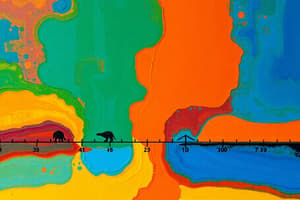Podcast
Questions and Answers
What is the primary composition of Earth's core?
What is the primary composition of Earth's core?
- Aluminum and magnesium
- Iron and nickel (correct)
- Carbon and hydrogen
- Silicon and oxygen
When did the process of the 'iron catastrophe' occur?
When did the process of the 'iron catastrophe' occur?
- Over 4.5 billion years ago
- Between 2 billion to 1 billion years ago (correct)
- Less than 100 million years ago
- Within the last 1000 years
What drives the generation of Earth's magnetic field?
What drives the generation of Earth's magnetic field?
- Interaction between the solid inner core and the molten outer core (correct)
- Rotation speed of the Earth
- The presence of water on the surface
- Atmospheric pressure changes
What primarily protected Earth from solar winds throughout its history?
What primarily protected Earth from solar winds throughout its history?
During the 'iron catastrophe,' which elements were also driven to Earth's core alongside iron?
During the 'iron catastrophe,' which elements were also driven to Earth's core alongside iron?
After forming around 4.54 billion years ago, what was Earth primarily composed of?
After forming around 4.54 billion years ago, what was Earth primarily composed of?
What is one of the most significant developments in Earth's history?
What is one of the most significant developments in Earth's history?
What was the composition of Earth's earliest atmosphere?
What was the composition of Earth's earliest atmosphere?
What caused Earth's days to be only 19 hours long for a billion years?
What caused Earth's days to be only 19 hours long for a billion years?
What is a key tool used by geoscientists to study Earth's interior?
What is a key tool used by geoscientists to study Earth's interior?
Which rocks contain the earliest signs of life, including bacteria and oxygenic photosynthetic bacteria?
Which rocks contain the earliest signs of life, including bacteria and oxygenic photosynthetic bacteria?
What is a significant contribution to understanding Earth's history according to the text?
What is a significant contribution to understanding Earth's history according to the text?
Flashcards are hidden until you start studying
Study Notes
Earth's History
Our planet, Earth, has a rich and complex history that spans over 4.6 billion years. This history is marked by numerous geological, atmospheric, and biological developments, shaping the planet as we know it today.
Earth's Formation and Early History
Earth formed around 4.54 billion years ago, a time when the solar system was still taking shape. It was initially a molten mass of rock, gas, and metal, with a relatively thin crust. Over time, the Earth cooled, and its interior solidified, forming a core composed primarily of iron and nickel.
The Inner Core and the Iron Catastrophe
The inner core, which solidified later than the outer core, is believed to have formed around 2 billion to 1 billion years ago. This process is known as the "iron catastrophe," during which molten iron sank to the center of the Earth due to its high density, forming the inner core. This event also drove heavy siderophile elements like nickel and gold to the core.
The Magnetic Field and Geodynamo
Earth's magnetic field is a crucial aspect of its history. The field is generated by the geodynamo, a process driven by the interaction between the solid inner core and the molten outer core. This interaction creates a self-sustaining circulation, which in turn generates a strong magnetic field with two opposing poles.
The geodynamo has been active for most of Earth's history, protecting the planet from solar winds, charged particles ejected by the sun. However, there are indications that Earth's magnetic field was weak around 900 million to 600 million years ago, with the potential for a collapse around 565 million years ago. After this, the inner core solidified, and the geodynamo began.
Atmospheric Evolution
Earth's atmosphere has also undergone significant changes throughout its history. The earliest atmosphere was composed of methane, ammonia, water vapor, and neon, with no free oxygen. Over time, the atmosphere evolved, primarily due to interactions with the Earth's crust and biochemical processes associated with life.
The rise of biologically produced molecular oxygen, O2, as a major component of the atmosphere is one of the most significant developments in Earth's history. This process, which took hundreds of millions of years, was driven by the evolution of life, particularly unicellular organisms that produced oxygen through photosynthesis.
The Geologic Time Scale
The geologic time scale is a useful tool for understanding Earth's history. It divides Earth's history into eons, eras, periods, and epochs. The oldest known rocks, dating back over three billion years, are found in the Transvaal, and they contain the earliest signs of life, including bacteria and oxygenic photosynthetic bacteria.
Day Length and Earth's Rotation
Earth's rotation and day length have also changed over time. Recent research has shown that for a billion years of Earth's history, our days were only 19 hours long. This was due to the moon's closer proximity to Earth, which stole some of the planet's rotational energy, causing it to move into a higher orbit.
The Role of Geoscientists
Geoscientists play a crucial role in understanding Earth's history. They use a variety of tools, including diamond anvil cells and computer modeling, to study the planet's interior. They also study geoneutrinos, neutrinos released by the natural radioactive decay of potassium, thorium, and uranium in Earth's interior, to better understand the composition and distribution of materials in the mantle and core.
In conclusion, Earth's history is a rich tapestry of geological, atmospheric, and biological events that have shaped our planet into the complex and diverse world we inhabit today. Understanding this history requires a multidisciplinary approach, drawing on expertise from geology, physics, biology, and many other fields.
Studying That Suits You
Use AI to generate personalized quizzes and flashcards to suit your learning preferences.




